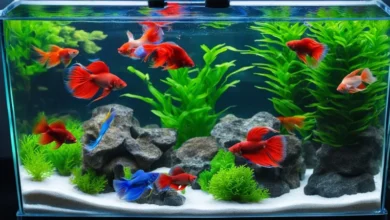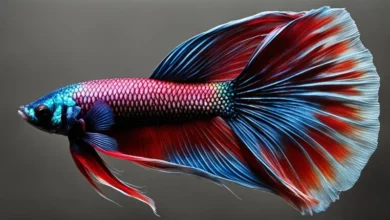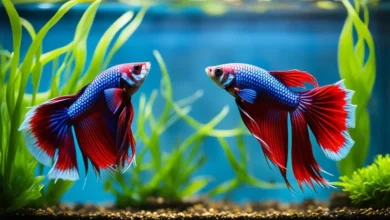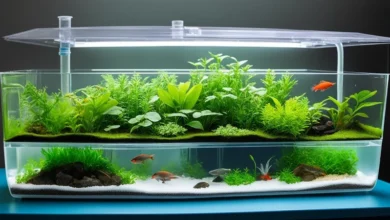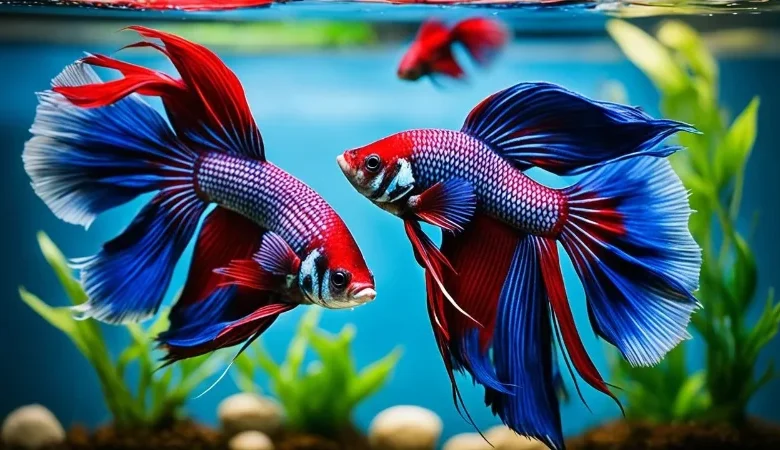
Have you ever wondered what goes on in the underwater world of betta fish breeding? What are the secrets behind their mesmerizing courtship rituals and mating habits? And how can you ensure the success of breeding betta fish pairs? If you’re a betta fish enthusiast or considering diving into the world of betta breeding, you’re in for a treat.
In this article, we will unravel the fascinating behavior of betta fish during the breeding process, explore the techniques for breeding betta fish, and delve into the dynamics of breeding pairs. Get ready to embark on a journey into the captivating world of betta fish breeding behavior.
Distinguishing Male and Female Betta Fish
Distinguishing between male and female betta fish is crucial for successful breeding. Understanding the differences in coloration, fin size, aggression, and behavior can help betta fish breeders create the ideal breeding environment. Let’s explore these distinguishing factors in more detail.
Coloration and Fin Size Differences
Male betta fish are known for their stunning and vibrant colors. They display a wide range of hues, including shades of red, blue, green, purple, and yellow. Their colorful appearance is a result of years of breeding and selection for desired traits.
On the other hand, females tend to have less vibrant coloration. They often have more subdued shades of their male counterparts’ colors, with a focus on earth tones like brown, gray, and olive. While their colors may be less striking, female bettas can still exhibit beautiful patterns and markings.
Another noticeable difference between male and female bettas is their fin size. Male bettas have larger and more elaborate fins compared to females. Their fins can be long and flowing, creating an impressive display. In contrast, female bettas have smaller and more streamlined fins, which allows them to swim faster and more efficiently.
Understanding Aggression Among Male Betta Fish
Aggression is a natural behavior among male betta fish, especially when they encounter other males. In the wild, male bettas fight for territory and breeding rights. This aggressive behavior is caused by their instinct to protect their breeding grounds and ensure the survival of their offspring.
When introducing two male bettas, it is essential to be cautious and provide ample space for each fish to establish its territory. Additionally, betta fish breeders must carefully monitor the interactions between males to prevent serious injuries or fatalities. Separating the males with dividers can help minimize aggression while still allowing visual contact, which can stimulate their natural behavior.
The Significance of Bubble Nesting in Males
Male betta fish exhibit a fascinating behavior known as bubble nesting. They create intricate nests on the water’s surface using bubbles and saliva. These nests serve as a safe space for eggs to be deposited during the breeding process.
Bubble nesting is a sign of male bettas reaching sexual maturity and preparing to reproduce. It signifies their readiness for courtship and mating. Betta fish breeders observe the construction and maintenance of bubble nests as an indicator that the male is ready to breed.
The Prelude to Betta Fish Courtship
Before the courtship and mating rituals begin, there is a prelude to betta fish courtship. This stage involves the male and female bettas interacting and preparing for the mating process. Understanding these pre-courtship behaviors is important for betta fish breeders to ensure a successful breeding environment.
The male betta typically initiates the courtship process by displaying his vibrant colors and building a bubble nest. The bubble nest is an essential part of the courtship process and serves as a safe place for the eggs to be deposited. Female bettas may show their interest by approaching the male and displaying submissive behaviors.
It is crucial for betta fish breeders to observe these pre-courtship behaviors and provide a suitable environment for the bettas to engage in their natural courtship rituals. By understanding the prelude to betta fish courtship, breeders can create optimal conditions for successful breeding and ensure the health and well-being of the betta fish.
Betta Fish Breeding Behavior
Betta fish breeding behavior involves several fascinating behaviors that occur during the mating process. From the intricate mating dance of bettas to the depositing of eggs and the role of mucus, these behaviors showcase the complexity and beauty of the breeding process.
The Mating Dance of Bettas
One of the most captivating aspects of betta fish breeding behavior is the mating dance performed by the male and female bettas. This elaborate dance involves a series of movements and displays that signal their readiness to mate. The male betta showcases his vibrant colors and flaunts his flowing fins to attract the attention of the female. The dance is a mesmerizing sight to behold and plays a crucial role in initiating the breeding process.
Egg Depositing and the Role of Mucus
After the mating dance, the female betta deposits her eggs. This process is done in close coordination with the male, who releases mucus to aid in the fertilization of the eggs. The female carefully releases her eggs, which the male then collects in his mouth and fertilizes with the mucus. This protective mucus not only ensures successful fertilization but also provides a safe environment for the developing offspring.
Pre-Spawn Pursuit and Aggression Patterns
Before the actual spawning occurs, there is a pre-spawn pursuit phase where the male betta relentlessly pursues the female. This pursuit is often accompanied by aggressive behaviors, including fin flaring and nipping, as the male establishes his dominance and defends his territory. These aggression patterns are a natural part of the breeding process and are essential for successful reproduction.
Understanding and appreciating the intricacies of betta fish breeding behavior is crucial for betta fish breeders. By observing and providing a suitable environment that mimics their natural habitat, breeders can maximize the chances of successful breeding and contribute to the preservation of these beautiful fish species.
Creating the Perfect Betta Fish Breeding Tank Setup
In order to ensure successful breeding, it is crucial to create the perfect betta fish breeding tank setup. Providing the ideal environment for betta fish breeding is essential for the health and well-being of the breeding pair. Here are some important considerations for setting up your betta fish breeding tank:
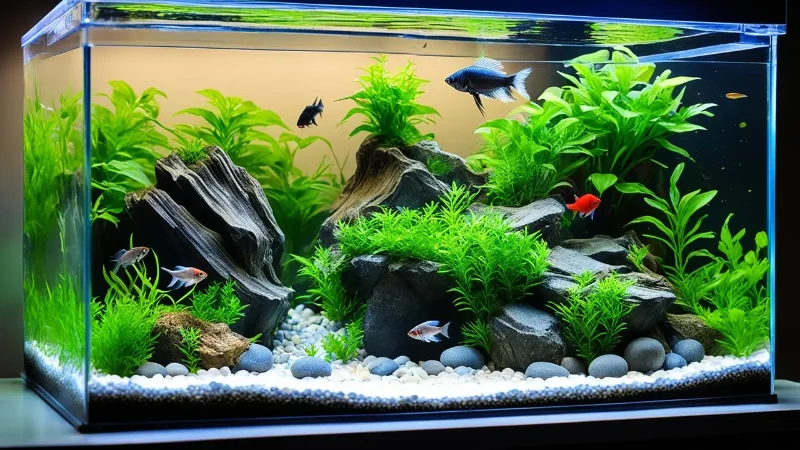
- Tank Size: Choose a tank that is spacious enough to accommodate the breeding pair comfortably. A tank with a capacity of at least 10 gallons is recommended to provide enough space for the bettas.
- Water Parameters: Maintain optimal water conditions for the betta fish. The water temperature should be kept between 78-82°F (25-28°C) and the pH level should be around 7.0. Regular water testing is important to ensure the parameters remain stable.
- Appropriate Hiding Spots: Include suitable hiding spots in the breeding tank to provide privacy and security for the bettas. Live or artificial plants, caves, and floating plants can serve as hiding spots where the bettas can relax and retreat when needed.
- Separate Breeding Tank: It is recommended to set up a separate breeding tank rather than using the bettas’ regular tank. This helps minimize distractions and disruptions in the breeding process, providing a dedicated space for the breeding pair.
By following these breeding tank requirements, you can create an environment that promotes successful breeding and ensures the well-being of your betta fish. Remember to regularly monitor and maintain the tank conditions to provide the best possible care for your breeding pair.
The Complex Dance of Betta Fish Mating Habits
Betta fish mating habits are a fascinating and intricate process that involves a complex dance between the male and female fish. Understanding these mating habits is crucial for betta fish breeders seeking to ensure successful reproduction.
In this section, we will explore the signs of readiness to mate exhibited by betta fish, including physical changes and behaviors. We will also delve into the specific mating behavior and female submission displayed by these magnificent creatures.
Identifying Signs of Readiness to Mate
Before betta fish engage in the mating process, there are certain signs of readiness that breeders can observe. These signs include:
- Flaring of the gills and fins.
- Intense coloring and vibrant displays.
- Frequent swimming near the water’s surface.
- Building bubble nests by the male betta.
By recognizing these signs, breeders can determine when their betta fish are ready to mate and take the necessary steps to facilitate the breeding process.
Mating Behavior and Female Submission
During the mating process, male and female bettas engage in a fascinating dance that involves specific behaviors and interactions. The male betta actively courts the female, displaying colorful fin displays and creating bubble nests to entice her. The female, in turn, displays signs of submission, such as turning pale and allowing the male to lead.
This dance of courtship and submission is essential for successful mating to occur and should be carefully observed by breeders. By understanding and respecting the natural behaviors of these fish, breeders can create an environment in which betta fish can thrive and reproduce.
Now, let’s take a closer look at the intricate courtship rituals and behaviors that betta fish exhibit during their mating process.
Caring for Betta Fish Breeding Pairs
Caring for betta fish breeding pairs requires special attention and care. Understanding the dynamics between the male and female bettas is crucial to ensure a successful breeding process and the health of the breeding pair.
When it comes to compatibility, it’s essential to select betta fish breeding pairs that complement each other. Consider factors such as their temperament, size, and overall health. Introducing a male and female betta that are compatible can greatly increase the chances of a successful breeding outcome.
Feeding requirements for betta fish breeding pairs should be carefully considered. Providing a nutritious and balanced diet is crucial to support the health and reproductive capabilities of both the male and female. Consult with a knowledgeable fish expert or veterinarian to ensure that the breeding pair’s nutritional needs are met.
Additionally, it is important to take necessary precautions to guarantee the well-being of the breeding pair. This may include providing a suitable breeding tank setup, regular monitoring of water parameters, and maintaining a stress-free environment. Avoid any sudden changes to the habitat or disruptions that could cause stress to the breeding pair.
By caring for betta fish breeding pairs with proper attention, ensuring compatibility, providing nutritious diets, and taking necessary precautions, you can create the ideal environment for successful breeding and the overall welfare of the betta fish.
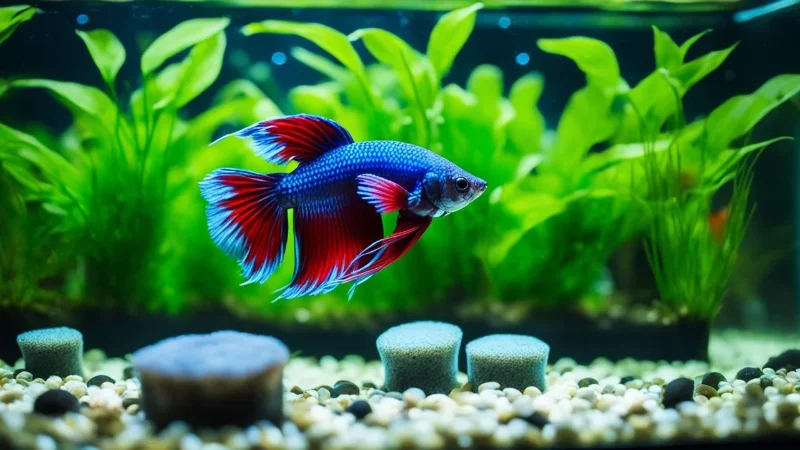
Betta Fish Spawning Behavior and Nesting Habits
Betta fish have specific spawning behaviors and nesting habits that are crucial for successful breeding. Understanding these behaviors and habits is essential for betta fish breeders to create an optimal breeding environment. Let’s explore how male bettas construct and maintain bubble nests and delve into the parental roles of both male and female bettas post-spawning.
Construction and Maintenance of Bubble Nests
Male bettas are responsible for constructing and maintaining bubble nests. These nests are crucial for the successful breeding of betta fish. Male bettas create bubble nests by blowing bubbles that adhere together and form a floating nest at the surface of the water. The construction process involves the careful placement of bubbles using their mouths and fins.
The bubble nests serve as a safe haven for the fertilized eggs and subsequent betta fish fry. The male betta tirelessly maintains the bubble nest, adding or repairing bubbles as necessary to ensure stability. This process helps protect and incubate the eggs, providing an ideal environment for their development.
Parental Roles Post-Spawning
After spawning, both the male and female bettas play important roles in caring for the eggs and fry. The male betta guards and protects the bubble nest, ensuring the safety of the eggs. He also uses his mouth to retrieve any eggs that have fallen from the nest and gently places them back into the nest.
The female betta, on the other hand, takes on a nurturing role post-spawning. She plays an essential part in maintaining the cleanliness and health of the bubble nest. She removes any infertile or damaged eggs from the nest to prevent fungus or parasites from harming the viable eggs.
As the fry hatch from the eggs, the male betta continues to guard the nest and provide protection. He also initiates swim lessons by encouraging the fry to swim near the surface and take breaths of air from the bubblenest. This behavior helps build the fry’s strength and allows them to develop their labyrinth organ, which enables them to breathe atmospheric air.
In summary, understanding the spawning behavior and nesting habits of betta fish is crucial for successful breeding. Male bettas exhibit impressive skills in constructing and maintaining bubble nests, while both males and females play vital roles in the care and protection of the eggs and fry post-spawning.
Monitoring Betta Fish Fry Development
Once the breeding pair has spawned, it is important to closely monitor the development of the betta fish fry. This will ensure their growth and survival as they go through various stages of development. The care provided during this critical period is crucial for their overall health and well-being.

During the early stages, the betta fish fry are tiny and delicate. They rely on a healthy diet and optimal water conditions to thrive. It is essential to provide them with a nutritious diet consisting of finely crushed or powdered fish food. This will ensure that they receive the necessary nutrients for their growth and development.
Regular water changes are essential to maintain clean and stable water conditions. Frequent monitoring of water parameters such as temperature, pH, and ammonia levels is crucial to prevent any potential harm to the fry. Implementing a filtration system, such as a sponge filter, can help maintain water quality and provide a gentle flow that won’t overwhelm the vulnerable fry.
As the betta fish fry grow, they will start developing their characteristic fins and colors. It is important to observe their progress and ensure that they are growing at a healthy rate. Any signs of stunted growth or abnormalities should be addressed promptly to prevent any further complications.
Provide plenty of hiding spots and plants in the fry tank to mimic their natural environment. This will offer the fry a sense of security and reduce stress. Additionally, maintaining a consistent and suitable temperature range will promote optimal growth and development.
In conclusion, monitoring the betta fish fry development is a crucial step in successful breeding. By ensuring proper nutrition, water quality, and a suitable environment, betta fish fry can grow into healthy and vibrant adult bettas. Remember to be patient and attentive throughout this process, as it plays a vital role in the long-term success of your breeding endeavors.
Cultivating a Safe Environment for Breeding Bettas
Creating a safe environment is crucial for the health and well-being of bettas during the breeding process. By implementing certain measures, you can ensure a safe and stress-free environment for your breeding pair.
Separation and Protection of Fish
It is important to separate the male and female bettas before introducing them for breeding. Keeping them in separate tanks allows you to closely monitor their behavior and prevents any potential harm or aggression towards each other. This separation period also helps stimulate the breeding instinct in bettas, preparing them for successful reproduction.
During the breeding process, it is essential to protect the fish from external disturbances and stressors. Place the breeding tank in a quiet area with minimal human traffic to minimize any disruptions. Ensure the tank has a secure lid to prevent any accidental escapes or drafts that could harm the fish. Maintaining a stable and clean water environment is also crucial for the health and breeding success of bettas.
Managing Aggression Post-Breeding
After the breeding process is complete, it is common for male bettas to display aggression towards the female or fry. To manage aggression post-breeding, it is recommended to remove the female from the breeding tank and place her in a separate tank or community tank. This separation helps protect the female and allows the male to focus on caring for the fry without any potential conflict.
Additionally, providing ample hiding spots, such as caves or plants, in the breeding tank can help reduce aggression by creating separate territories for the bettas. This allows each fish to establish their own space and minimize any confrontations.
By implementing these strategies, betta breeders can create a safe environment that promotes successful breeding and ensures the well-being of the fish. Remember, responsible betta breeding practices prioritize the safety and health of these beautiful fish.
Conclusion
In conclusion, understanding betta fish breeding behavior is essential for successful breeding. Throughout this article, we have explored the fascinating world of betta fish courtship, mating rituals, and the dynamics between male and female bettas. By recognizing the distinguishing characteristics of male and female bettas, observing their pre-courtship behaviors, and understanding the intricacies of their mating dance, breeders can create the perfect breeding tank setup and provide a safe environment for the breeding pair.
To achieve successful betta breeding, it is crucial to monitor the development of the fry and care for them appropriately. This includes maintaining optimal water parameters, ensuring adequate nutrition, and creating a harmonious environment that minimizes aggression. By implementing responsible breeding practices, we can promote the well-being of these beautiful fish and contribute to their preservation in the hobby.
As you embark on your journey as a betta fish breeder, remember the importance of knowledge, patience, and dedication. By understanding and respecting betta fish breeding behavior, you can enhance your breeding efforts and contribute to the continued success and enjoyment of these stunning aquatic creatures. Happy breeding!
